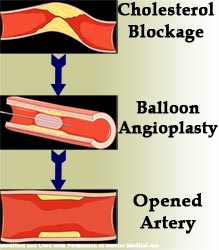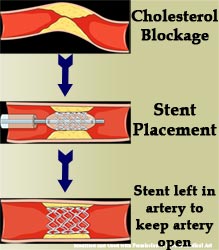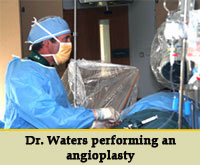In This Section
- Clinics
- Anticoagulation (Coumadin)
- Defibrillators
- Hypertension
- Pacemakers
- Tests & Treatments
- Ambulatory Rhythm Monitoring
- Angioplasty and Stents
- Ankle-Brachial Index (ABI)
- Biventricular Pacemaker
- Blood Pressure Monitoring
- Cardiac Catheterization
- Cardiac Computed Tomography
(CT) - Carotid Ultrasound
- Echocardiography
- Electrophysiology
- Exercise Stress Testing
- Pacemakers & Defibrillators
- Peripheral Vascular Disease
Angioplasty and Stents
 Following a cardiac catheterization, your cardiologist may determine that there is a significant cholesterol blockage in one or more of the arteries that feed the heart. If the amount of disease cannot be treated with medication alone, then the blockage can be opened mechanically with a balloon (angioplasty) or stent.
Following a cardiac catheterization, your cardiologist may determine that there is a significant cholesterol blockage in one or more of the arteries that feed the heart. If the amount of disease cannot be treated with medication alone, then the blockage can be opened mechanically with a balloon (angioplasty) or stent.
An angioplasty is performed by a similar procedure to a diagnostic cardiac catheterization but may take 1 to 2 hours. The same small hollow tubes are used and dye is injected into the arteries that feed the heart. Once a blockage is identified, a small narrow wire, the width of a hair, is inserted past the blockage and a deflated cigar-shaped balloon is guided over the wire. The balloon is then placed in the location of the blockage and is inflated under high pressure to push the cholesterol plaque into the walls of the artery allowing blood to again flow freely through the artery. Depending on the blockage, multiple inflations may be necessary to restore blood flow. After the procedure, the wire and balloon are both removed from the body. If the anatomy of the artery is appropriate, a stent is often used to buttress the artery after the narrowed portion of the artery is opened.
If the anatomy of the artery is appropriate, a stent is often used to buttress the artery after the narrowed portion of the artery is opened.
Similar to an angioplasty, a balloon is placed over the site of the blockage, but in this case, a stent covers the balloon and is expands into the wall of the artery when the balloon is inflated. The wire and balloon are then both removed as in an angioplasty, but the stent is left behind. In the right patient, it is often more effective than angioplasty in helping to keep the artery open. It eventually becomes embedded in the artery and cannot be removed after it is placed. The stent is made of metal but certain conditions may benefit from a drug impregnated onto the stent to prevent the blockage from growing back. These drug-coated stents are not for every patient, and your cardiologist can help decide which is best for you. In either situation the patient will need to take both aspirin and clopidogrel (Plavix®) for at least a month and with drug coated stents, for at least a year. With both balloon angioplasty and stent procedures, a plug is often placed in the artery to stop the bleeding or otherwise the site is compressed for about 10 or 15 minutes until the artery clots. There is a mandatory bed rest period after the procedure lasting from 2 – 6 hours. Traditionally, the patient is observed overnight and usually discharged the following day. However, MVC is following a nation wide trend by performing more procedures by the radial artery access, and even discharging patients the same day.
With both balloon angioplasty and stent procedures, a plug is often placed in the artery to stop the bleeding or otherwise the site is compressed for about 10 or 15 minutes until the artery clots. There is a mandatory bed rest period after the procedure lasting from 2 – 6 hours. Traditionally, the patient is observed overnight and usually discharged the following day. However, MVC is following a nation wide trend by performing more procedures by the radial artery access, and even discharging patients the same day.
Most angioplasty procedures can be performed safely at the Lowell General Hospital. Rare cases that are higher risk may be performed at the Lahey Clinic where cardiac surgery is available.
What to Expect Before the Procedure:
- If you have had a reaction to contrast, shellfish or iodine in the past, please let your cardiologist know immediately.
- Nothing to eat after the midnight before the procedure.
- You may take your pills with small sips of water.
- Diabetes pills should be held and if you take insulin, ask your physician how the dose should be adjusted.
- Glucophage (Metformin®) should be withheld the day before and a few days after the procedure.
- We prefer patients to continue aspirin and plavix if previously prescribed. If you take Coumadin, please ask your cardiologist if these should be withheld before the procedure.
- You may bring a CD of your favorite music to help you relax.
What to Expect After the Procedure:
- There may be soreness at the incision site and possibly some swelling and bruising.
- There may be a small, walnut-sized lump at the access site which should become smaller and becomes less tender within days.
- There may be a small area of bruising following the procedure which may seem to get larger and expand down the leg. This is often seen and does not typically represent ongoing bleeding, but often represents old blood under the skin which is traveling in the direction of gravity.
- Avoid any significant physical activity or heavy lifting for the first few days after the procedure.
- The patient may resume driving the day following the procedure.
- Avoid taking a bath for a few days; showers may be taken within 24 hours.
When to Call your Physician or 9-1-1:
- Bleeding at the access site. Pressure should be applied to the site by a friend/family member until medical advice is obtained.
- Severe tenderness, discharge or fever.
Complications:
Complications of the procedure are rare but could include a blood vessel tear or bleeding, reaction/allergy to medication or contrast, kidney complications or very rarely stroke or heart attack.
To learn more about angioplasty and stenting, click here.